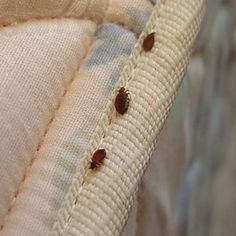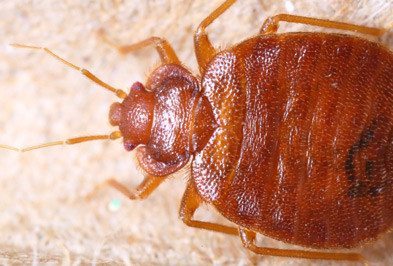Premier Bed Bug Exterminator: DC Exterminator for Effective Treatment
Premier Bed Bug Exterminator: DC Exterminator for Effective Treatment
Blog Article
Checking Out the Scientific Research Behind Bed Insect Warmth Treatments as a Lasting Insect Administration Technique
One such approach that has gotten traction in recent years is the usage of heat therapies to combat bed pest invasions. The details of exactly how heat efficiently removes bed insects and the broader ramifications for sustainable bug management techniques make this a subject worth discovering further.
Bed Insect Warm Therapy Refine

Thermal Fatality Factor for Bed Bugs
Subjecting bed pests to raised temperatures beyond their thermal resistance array is critical for attaining effective obliteration in heat therapy processes. The thermal death point for bed insects describes the temperature level at which these insects can not endure. Study shows that bed bugs start to perish when exposed to temperatures above 113 ° F(45 ° C) for a continual period. As the temperature enhances, so does the mortality price of bed insects. At around 118 ° F(48 ° C ), bed pests start to die rapidly, with a death rate of almost 99% within minutes of exposure. This shows the level of sensitivity of bed pests to high temperatures and highlights the performance of warm treatments in eliminating infestations. By getting to and maintaining temperature levels above the thermal fatality factor for bed pests, insect monitoring experts can ensure detailed elimination of bed insect populaces, consisting of hard-to-reach locations where chemical treatments might be less efficient. Comprehending the thermal fatality factor for bed insects is necessary for carrying out successful warm treatment strategies and attaining sustainable insect management outcomes.
Benefits of Warm Treatments
Having actually established the crucial thermal death point for bed bugs, it is important to currently discover the substantial benefits that warmth treatments supply in effectively eliminating these resilient bugs. Heat therapies present a number of crucial advantages when compared to conventional chemical approaches. One of the key advantages is that warm can penetrate deep right into splits and gaps where bed insects hide, making certain that also the most hard-to-reach areas are heated to deadly temperatures. This detailed strategy not only eliminates live insects however additionally targets bed insect eggs, avoiding future invasions.
Furthermore, warm therapies are safe and eco-friendly, making them a lasting bug administration approach. Unlike chemical pesticides, warmth treatments do not leave harmful deposits that can position risks to human health and wellness or the atmosphere. This element is especially essential in sensitive settings such as medical facilities, schools, and houses where chemical use might not be desirable.
Additionally, warm therapies have a high success rate in eliminating bed insect infestations in a single therapy, decreasing the requirement for multiple brows through and decreasing interruption to passengers. This performance not only conserves money and time but likewise offers satisfaction to those managing bed bug issues.
Performance of Warmth Therapy

Research studies have regularly shown the performance of warm treatments in attaining a high rate of bed insect death. Correctly conducted warmth treatments can get to all the splits and gaps where bed insects may be nurturing, making bed bug treatment certain a thorough method to elimination. Heat therapies have the added advantage of eliminating bed insect eggs, which are commonly resistant to traditional chemical therapies. On the whole, the performance of heat treatments in getting rid of bed bug infestations makes them a dependable and sustainable bug monitoring strategy.
Lasting Insect Management Advantages
Applying lasting bug administration methods offers long-lasting advantages for both the setting and public wellness. By making use of approaches such as warm treatments for parasite control, we can minimize the reliance on harmful chemical pesticides that can have unfavorable impacts on environments and human health - bed bug heat treatment. Sustainable bug administration techniques assist in protecting biodiversity by targeting particular bugs without hurting non-target microorganisms, thereby preserving a well balanced environment
Additionally, sustainable insect monitoring techniques add to the total health and health of the public. By decreasing direct exposure to harmful chemicals utilized in typical parasite control methods, warmth treatments offer a safer option for bug management in property, commercial, and public areas. This reduction in chemical use also assists in stopping pesticide deposits from infecting water, air, and dirt, protecting ecological high quality.
Verdict
To conclude, bed bug warmth treatments have been shown to be a sustainable and efficient parasite management technique. The thermal death factor for bed insects makes them susceptible to heat therapies, which have countless advantages over standard chemical treatments. The performance of heat treatments in getting rid of bed insect invasions while minimizing environmental impact highlights the capacity of this approach as a lasting remedy for pest control.
The bed bug heat treatment process involves increasing the temperature level within plagued areas to a degree that successfully gets rid of bed insects and their eggs. By reaching and maintaining temperature levels over the thermal death point for bed bugs, pest monitoring experts can ensure extensive removal of bed pest populations, including hard-to-reach locations where chemical therapies may be less efficient. One of the primary benefits is that warmth can permeate deep into fractures and gaps where bed bugs hide, making sure that even the most hard-to-reach areas are heated up to dangerous temperatures. Unlike chemical treatments that may leave behind immune populaces, heat therapies provide a safe and ecologically friendly service that can penetrate deep right into furniture, wall surfaces, and other hard-to-reach locations where bed bugs hide.
The thermal fatality point for bed insects makes them susceptible to warm treatments, which have many advantages over typical chemical treatments.
Report this page